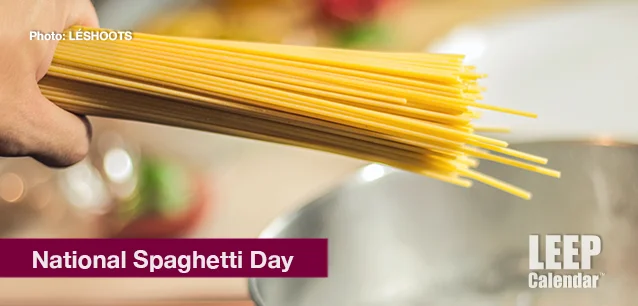 AD
AD
Today is: November 10
Scroll to explore events active on this date.
LEEP INK FEATURES

August? Absolutely!
In August, we live through the Dog Days of Summer. It's hot and often humid, and those who can leave for better climates do. Down south, winter is in full force. August is also known as "the ...

In The Heat of July: July 2025 Events
Is it hot enough (or cold enough if you're below the equator) for you yet? There is actually a day for that! Like every month, I pick a diverse collection of events you may or may not know about. This ...

May Blooms: Events in May 2025
Along with October, May is one of the most densely packed months of the year. It's before the summer humidity and the last whole month of the school year. The weather is warming in t...
About National Spaghetti Day
European Countries , United States
Ends: Jan 04, 2024
DESCRIPTION:
National Spaghetti Day celebrates the round wheat noodle known as spaghetti.
The ancient Greeks first wrote about spaghetti nearly 3,000 years ago. Later the lauded Roman statesman and poet Cicero documented his love for spaghetti and his propensity to overindulge.
When archaeologists uncovered the remains of the Mount Vesuvius and Mount Etna eruptions of the first century, they found spaghetti and the instruments used to make the pasta.
During this period, and well before the Islamic era, Arab cultures of the Gulf and Levant fashioned dried pasta in strips. Arabians of western Asia were nomadic peoples who shared their version of dried pasta throughout East, South, and West Asia.
When Islam conquered Sicily in June 827 AD, the culinary arts of Europe and Asia met. To this day, they share similarities in cuisine.
During the 12th century, Abu Abdullah Mohammed al Idrisi wrote of the importance of spaghetti to Sicilian culture in "The Book of Roger," noting specifically the town of Trabia in Sicily. Here, the natives made the dough using hard wheat into long strands that they then exported to other areas.
A century later, Marco Polo traveled to and lived for several years in China, and he may have carried spaghetti with him. The Chinese also create noodles, not from wheat but rice. For some reason, the legend persists that Marco Polo brought pasta to Europe. No, the Greeks ate it first.
What about the red sauce now associated with spaghetti?
Tomatoes arrived in Europe from Central and South America via the Spanish Conquistadors during the 16th century. The Aztec word "xitomati" is the original name. It would take a while for the funky fruit to catch on, nearly 200 years.
Legend suggests its popularity soared after being rumored to be an aphrodisiac in aristocratic circles. The French called tomatoes "love apples."
Tomatoes proliferate quickly, making them accessible to ordinary people. By the mid-18th century, this inexpensive and easy-to-grow food became a staple in southern European diets. However, the sauce would not be complete until the mid-19th century, when India's contribution of fresh basil was added.
Therefore, if you sit down to a plate of spaghetti today, thank the Greeks, Romans, Arabs, Aztecs, Spanish, Indians, and Italians. Your plate of pleasure is 3,000 years and three continents in the making!
VIDEOS
Currently, this event does not have supporting videos.
SUPPORTING DOCUMENTS
Currently, this event does not have supporting documents.
ADDITIONAL IMAGES
Currently, this event does not have supporting images.
Where would you like to go now?
 AD
AD


/footer-logo.svg)
